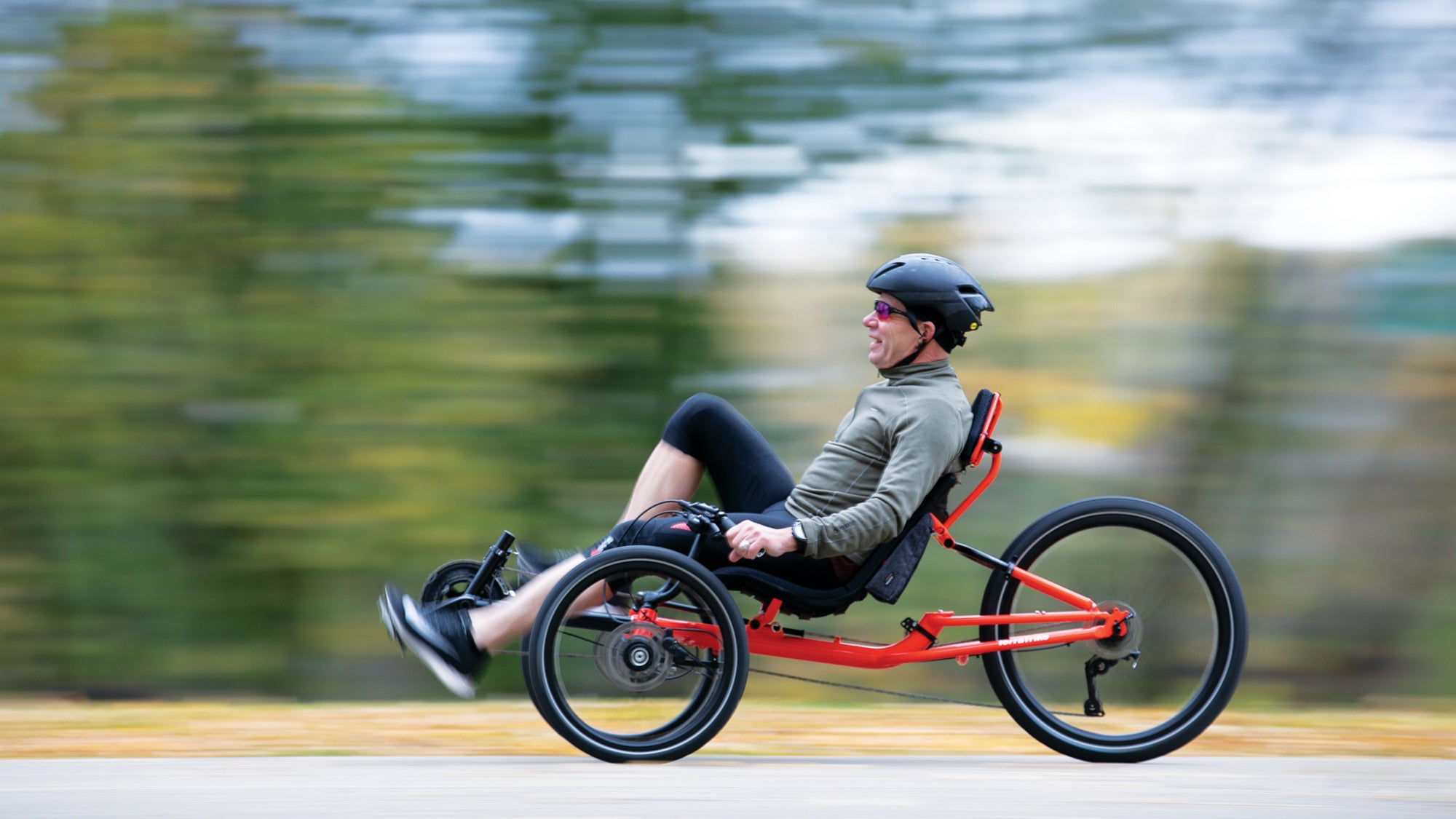History of the Recumbent Tricycle
The recumbent adult tricycle or “trike” continues to grow in popularity. Recumbent trikes are, to many people, the ultimate ride offering comfort, stability, and staying power. So, how did the modern trike reach its current state and popularity? Let’s look at the history of the recumbent tricycle and the many changes this little machine has experienced since its conception way back in the late 1800s.
It Starts with the Safety Bike
We actually have to look at the history of the bike first. It was in the late 1890s that we see the first geared recumbents appear after the invention of the popular “safety bike” by J.K. Starley and Sutton in 1884. The safety bike was the closest to the bikes we ride today, with two wheels of the same size, a center saddle and peddles with a chain. It brought riders closer to the ground, making it easier to mount the bike, unlike the cumbersome and frankly perilous “velocipede” or “penny farthing” bikes of earlier days. The safety bike is the template still used today, offering better control, sturdier frames, and an improved bike riding experience.
Which Leads to the “Normal” Bike
Now, back to recumbents. Charles Challand, an Italian professor living in Geneva, designed what he dubbed the “Normal Bicycle,” the first geared recumbent bike. This precursor to today’s recumbent got its name because, in the eyes of the professor, riding in a reclined position was more natural than awkwardly hunching over the bars of a safety bike. Now, we can go on and on about the many variants of the normal bike but let’s long-story-short-it instead:
1896: Irving Wales of Rhode Island creates a recumbent with hand drive that works like a rowing machine to propel the bike forward, relying on the arms as opposed to the legs.
1901: Harold Jarvis of Buffalo creates a longer wheelbase recumbent with a smaller front wheel and standard rear wheel, steered with a chain-and-sprocket link known as the sofa bike.
1905: P. W. Bartlett of Richmond, England, creates a short wheelbase with the front wheel much smaller at just 16 inches but with the addition of a comfy chair.
1914: A similar design to the sofa bike, an Italian inventor by the name of Guglielmo introduces a steering wheel instead of handlebars. At the same time, a long-wheelbase recumbent bicycle appears in France with possible ties to car company Peugeot, with a much larger rear wheel of 26 inches.
1921: Australian Paul Jaray working for the Zeppelin company, develops a treadle-driven recumbent dubbed the J-Rad, which became widely popular for middle-class families in the Netherlands.
The 1930s Recumbent Boom
We eventually end up in the mid-1930s when interest in recumbents hit a boom in Europe. Italian engineer Ernesto Pettazzoni developed the Velocino, an ultra-short-wheelbase semi-recumbent machine with a tiny 10-inch front wheel and standard rear wheel. Apparently, Mussolini commissioned the Velocino for easy urban transportation, but World War II put an end to that. We see many iterations of the recumbent through the 1930s, including:
1934: The Kington, designed by F. H. Grubb Ltd. of Brixton features a long-wheelbase with under-seat steering and 20-inch wheels with a welded “stretched” diamond frame and the more recognizable low seat. This leads to the Velocycle with a single main tube replacing the diamond frame, which is closer to the recumbents we see today.
1935: The Moller Auto-Cycle is introduced by Holger Møller of Copenhagen and manufactured by Triumph in England with an indirect steering system and steering wheel. The same year the French Ravat-Wonder factory produces the Ravat Horizontal designed by Henri Martin, which led to the sports version with a 28-inch rear wheel with Reynolds lightweight tubing.
All told, the most popular was Charles Mochet’s Vélo-Vélocars which is too long a story to share here. We’ll fast forward to 1932 when the Vélo-Vélocar receives the Grand Prix Lepine for indirect steering for recumbent cycles.
The following summer a racing version of the recumbent broke records for 5-kilometer, 10-kilometer, 20-kilometer, 30-kilometer, 40-kilometer, and 50-kilometer showing the world recumbents were much faster than standard bikes. The many race-focused refinements that came after made this recumbent the most influential of 1930s designs. Henri Martin, a worker of Mochet’s, went on to invent the iconic Ravat Horizontal in 1934.
Picking Up Production
While a few things went on in the 1940s, it isn’t until 1964 that the design of the Velocino gets a second chance thanks to Dutch manufacturer Union. They create the Strano designed by Bernard Overing of Deventer, and the next year, Emil Friedman of Germany shows off his take on the same idea with his “Donkey cycle.” In 1968, Captain Dan Henry builds a long-wheelbase recumbent with sprung 27-inch front wheels.
However, smaller front wheels are preferred because they have higher rolling resistance, weigh less, and have less air resistance for better steering. In 1967, David Gordon Wilson holds a cycle-design competition with first prize going to the recumbent Bicar designed by W. G. Lydiard. In 1972, H. Frederick Willkie II of Berkeley, California, designs a short-wheelbase recumbent called Green Planet Special 1, inspired by Wilson and unknowingly very similar to the Ravat Horizontal. His improvements to his design include the following:
- Lower cranks
- Moving the small front wheel back to clear the rider’s heels
- Under-seat steering
- Improved seat, wheelbase, and geometry
The Finish Line
There are endless versions of recumbents in the 70s and 80s, from the Avatar 2000 to the Bluebell and the Easy Racer to the Vector. But these recumbents were all about racing and speed. It took a lot of technical advancements to get to where we are today with recumbent trikes sold in the mainstream. However, it was worth the wait. Their low-to-the-ground position makes it almost (almost) impossible to tip over, the absence of “handlebars” takes the pressure off the wrists, arms and neck, and the wide seat avoids the infamous saddle soreness or crotch pain of the traditional bike seat. The reclined position also reduces stress on the entire body, and knee pain is greatly reduced or even eliminated after long rides.
If you are interested in taking a modern recumbent trike out for a spin, pop into Laid Back Cycles.




